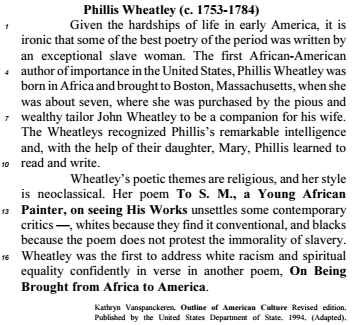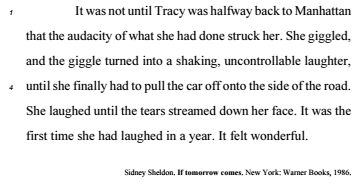Questões de Concurso Sobre inglês
Foram encontradas 17.625 questões

Based on the text above, choose the correct option.

Based on the comic strip above, choose the correct option.
Reading comprehension is a multi-dimensional process that includes the reader, the text, and factors associated with the activity of reading. Most research and theories of comprehension are based primarily on research conducted with monolingual English speakers (L1). The present study was designed to investigate the cognitive and linguistic factors that have an influence on reading comprehension in English-as-a-Second-Language (ESL) speakers. The cognitive aspects of reading comprehension among L1 speakers and ESL speakers in the seventh grade were investigated. The performance of both groups was compared and the role of some relevant processes, including word reading, word reading fluency, phonological awareness, working memory, and morphological and syntactic awareness were assessed. Within this sample, three groups were examined: children with poor comprehension (PC), children with poor word reading and poor comprehension (poor readers, PR) and children with both good word reading and comprehension abilities (good comprehenders, GC). The results demonstrated that a variety of cognitive processes, such as working memory and phonological, syntactic, and morphological awareness are important for reading comprehension and compromised in poor comprehenders. The GC group performed better than the PC group on all of the cognitive measures.
Orly Lipka and Linda Siegel. The Development of Reading Comprehension Skills in Children Learning English as a Second Language. In: Reading & writing. vol. 25, 2012, p. 1873-1898. Internet
Reading comprehension is a multi-dimensional process that includes the reader, the text, and factors associated with the activity of reading. Most research and theories of comprehension are based primarily on research conducted with monolingual English speakers (L1). The present study was designed to investigate the cognitive and linguistic factors that have an influence on reading comprehension in English-as-a-Second-Language (ESL) speakers. The cognitive aspects of reading comprehension among L1 speakers and ESL speakers in the seventh grade were investigated. The performance of both groups was compared and the role of some relevant processes, including word reading, word reading fluency, phonological awareness, working memory, and morphological and syntactic awareness were assessed. Within this sample, three groups were examined: children with poor comprehension (PC), children with poor word reading and poor comprehension (poor readers, PR) and children with both good word reading and comprehension abilities (good comprehenders, GC). The results demonstrated that a variety of cognitive processes, such as working memory and phonological, syntactic, and morphological awareness are important for reading comprehension and compromised in poor comprehenders. The GC group performed better than the PC group on all of the cognitive measures.
Orly Lipka and Linda Siegel. The Development of Reading Comprehension Skills in Children Learning English as a Second Language. In: Reading & writing. vol. 25, 2012, p. 1873-1898. Internet
Mr. Durrance’s shop was halfway up the village. It was on a corner site, had a few photographs displayed in the window, a couple of marriage groups, a kicking baby in a nudist condition on a rug, one or two bearded young men taken with their girls. None of the photographs were very good; some of them already displayed signs of age. There were also postcards in large numbers; birthday cards and a few special shelves arranged in order of relationships. To my Husband. To my Wife. One or two bathing groups. There were a few pocketbooks and wallets of rather poor quality and a certain amount of stationary and envelopes bearing floral designs. Boxes of small notepaper decorated with flowers and labeled For Notes.
Agatha Christie. Postern of Fate. New York: Signet. 2000.
According to the text above, chose the correct option.

Based on the text above, choose the correct option.
“Every educator is a teacher of reading,” the expression goes. That might be a difficult mantra to live by if you consider yourself a mathematician or historian. The truth is that despite your area of expertise, you will find yourself teaching reading and writing at some point during the day in middle or high school. You may be teaching reading to adolescents who struggle to read.
With the blitz of video gaming, social networking and texting, students are bombarded with information daily in multiple ways and settings. They are less interested in reading textbooks and course material and more interested in gathering information in a fast-paced, action-packed manner as they access all they need to know on phones, hand-held gaming devices, tablets or laptops. Moreover, teachers are faced with how to keep adolescents engaged with reading in today’s world and 21st-century classrooms.
Carianne Bernadowski. A Good Read: Literacy Strategy with Newspapers. In: Newspaper Association of America Foundation, 2011. Internet <www.americanpressinstitute.org> (adapted).
It can be concluded from the text above that
TSUNAMI VICTIM
By Charles Choi | October 25, 2017 1:00 pm
Paragraph 1 Tsunamis have claimed hundreds of thousands of lives in the
past two decades.Now a new study finds that a 6,000-year-old
skull may come from the earliest known victim of these killer
waves.
Paragraph 2 The partial human skull was discovered in 1929 buried in a
mangrove swamp outside the small town of Aitape Papua New
Guinea, about 500 miles north of Australia. Scientists originally
thought it belonged to an ancient extinct human species, Homo
erectus. However, subsequent research dated it to about 5,000
or 6,000 years in age, suggesting that it instead belonged to a
modern human.
A Rare Specimen
Paragraph 3 The skull is one of just two examples of ancient human remains
found in Papua New Guinea after more than a century of work
there. As such, archaeologists wanted to learn more about this
skull to elucidate how people settled this region.
Paragraph 4 The scientists went back to where this skull was found and
sampled the soil in which itwas discovered. They focused on
details such as sediment grain size and composition.
Paragraph 5 In the sediment, the researchers discovered a range of
microscopic organisms from the ocean known as diatoms. These
were similar to ones found in the soil after a 1998 tsunami killed
more than 2,000 people in Papua New Guinea — for instance,
their shells of silicawere broken, likely by extremely powerful
forces.
Paragraph 6 These diatom shells, combined with the chemical compositions
and the size ranges of the grains, all suggest that a tsunami
occurred when the skull was buried. The researchers suggested
the catastrophe either directly killed the person or ripped open
their grave.
Paragraph 7 Tsunamis, which are giant waves caused by earthquakes,
volcanic eruptions or underwater landslides, are some of the
deadliest natural disasters known. The 2004 tsunami in the
Indian Ocean killed more than 230,000 people, a higher death
toll than any fire or hurricane.
Paragraph 8 The site where the skull was found is currently about 7.5 miles
away from thecoast. Still, the researchers noted that back when
whoever the skull belonged to wasalive, sea levels were higher,
and the area would have been just behind the shoreline.
Paragraph 9 The waves of the tsunami that hit Papua New Guinea in 1998
reached more than 50 feet high and penetrated up to three miles
inland. “If the event we have identified resulted from a similar
process, it could have also resulted in extremely high waves,”
study co-lead author Mark Golitko, an archaeologist at the
University of Notre Dame in Indiana and the Field Museum in
Chicago.
Paragraph 10 These results show “that coastal populations have been
vulnerable to such events for thousands of years,” Golitko said.
“People have managed to live with such unpredictable and
destructive occurrences, but it highlights how vulnerable people
living near the sea can be. Given the far larger populations that
live along coastlines today, the potential impacts are far more
severenow.”
Paragraph 11 Golitko plans to return to the area over thenext few years “to
further study the frequency of such events, how the
environment changed over time, and how people have coped
with the environmental challenges of living in that environment.”
He and his colleagues detailed their findings Wednesday in the
journal PLOS O.
Retrieved and adapted from:
<http://blogs.discovermagazine.com/dbrief/2017/10/25/first-tsunami-
victim/#.WfYiYmhSzIU>
TSUNAMI VICTIM
By Charles Choi | October 25, 2017 1:00 pm
Paragraph 1 Tsunamis have claimed hundreds of thousands of lives in the
past two decades.Now a new study finds that a 6,000-year-old
skull may come from the earliest known victim of these killer
waves.
Paragraph 2 The partial human skull was discovered in 1929 buried in a
mangrove swamp outside the small town of Aitape Papua New
Guinea, about 500 miles north of Australia. Scientists originally
thought it belonged to an ancient extinct human species, Homo
erectus. However, subsequent research dated it to about 5,000
or 6,000 years in age, suggesting that it instead belonged to a
modern human.
A Rare Specimen
Paragraph 3 The skull is one of just two examples of ancient human remains
found in Papua New Guinea after more than a century of work
there. As such, archaeologists wanted to learn more about this
skull to elucidate how people settled this region.
Paragraph 4 The scientists went back to where this skull was found and
sampled the soil in which itwas discovered. They focused on
details such as sediment grain size and composition.
Paragraph 5 In the sediment, the researchers discovered a range of
microscopic organisms from the ocean known as diatoms. These
were similar to ones found in the soil after a 1998 tsunami killed
more than 2,000 people in Papua New Guinea — for instance,
their shells of silicawere broken, likely by extremely powerful
forces.
Paragraph 6 These diatom shells, combined with the chemical compositions
and the size ranges of the grains, all suggest that a tsunami
occurred when the skull was buried. The researchers suggested
the catastrophe either directly killed the person or ripped open
their grave.
Paragraph 7 Tsunamis, which are giant waves caused by earthquakes,
volcanic eruptions or underwater landslides, are some of the
deadliest natural disasters known. The 2004 tsunami in the
Indian Ocean killed more than 230,000 people, a higher death
toll than any fire or hurricane.
Paragraph 8 The site where the skull was found is currently about 7.5 miles
away from thecoast. Still, the researchers noted that back when
whoever the skull belonged to wasalive, sea levels were higher,
and the area would have been just behind the shoreline.
Paragraph 9 The waves of the tsunami that hit Papua New Guinea in 1998
reached more than 50 feet high and penetrated up to three miles
inland. “If the event we have identified resulted from a similar
process, it could have also resulted in extremely high waves,”
study co-lead author Mark Golitko, an archaeologist at the
University of Notre Dame in Indiana and the Field Museum in
Chicago.
Paragraph 10 These results show “that coastal populations have been
vulnerable to such events for thousands of years,” Golitko said.
“People have managed to live with such unpredictable and
destructive occurrences, but it highlights how vulnerable people
living near the sea can be. Given the far larger populations that
live along coastlines today, the potential impacts are far more
severenow.”
Paragraph 11 Golitko plans to return to the area over thenext few years “to
further study the frequency of such events, how the
environment changed over time, and how people have coped
with the environmental challenges of living in that environment.”
He and his colleagues detailed their findings Wednesday in the
journal PLOS O.
Retrieved and adapted from:
<http://blogs.discovermagazine.com/dbrief/2017/10/25/first-tsunami-
victim/#.WfYiYmhSzIU>
TSUNAMI VICTIM
By Charles Choi | October 25, 2017 1:00 pm
Paragraph 1 Tsunamis have claimed hundreds of thousands of lives in the
past two decades.Now a new study finds that a 6,000-year-old
skull may come from the earliest known victim of these killer
waves.
Paragraph 2 The partial human skull was discovered in 1929 buried in a
mangrove swamp outside the small town of Aitape Papua New
Guinea, about 500 miles north of Australia. Scientists originally
thought it belonged to an ancient extinct human species, Homo
erectus. However, subsequent research dated it to about 5,000
or 6,000 years in age, suggesting that it instead belonged to a
modern human.
A Rare Specimen
Paragraph 3 The skull is one of just two examples of ancient human remains
found in Papua New Guinea after more than a century of work
there. As such, archaeologists wanted to learn more about this
skull to elucidate how people settled this region.
Paragraph 4 The scientists went back to where this skull was found and
sampled the soil in which itwas discovered. They focused on
details such as sediment grain size and composition.
Paragraph 5 In the sediment, the researchers discovered a range of
microscopic organisms from the ocean known as diatoms. These
were similar to ones found in the soil after a 1998 tsunami killed
more than 2,000 people in Papua New Guinea — for instance,
their shells of silicawere broken, likely by extremely powerful
forces.
Paragraph 6 These diatom shells, combined with the chemical compositions
and the size ranges of the grains, all suggest that a tsunami
occurred when the skull was buried. The researchers suggested
the catastrophe either directly killed the person or ripped open
their grave.
Paragraph 7 Tsunamis, which are giant waves caused by earthquakes,
volcanic eruptions or underwater landslides, are some of the
deadliest natural disasters known. The 2004 tsunami in the
Indian Ocean killed more than 230,000 people, a higher death
toll than any fire or hurricane.
Paragraph 8 The site where the skull was found is currently about 7.5 miles
away from thecoast. Still, the researchers noted that back when
whoever the skull belonged to wasalive, sea levels were higher,
and the area would have been just behind the shoreline.
Paragraph 9 The waves of the tsunami that hit Papua New Guinea in 1998
reached more than 50 feet high and penetrated up to three miles
inland. “If the event we have identified resulted from a similar
process, it could have also resulted in extremely high waves,”
study co-lead author Mark Golitko, an archaeologist at the
University of Notre Dame in Indiana and the Field Museum in
Chicago.
Paragraph 10 These results show “that coastal populations have been
vulnerable to such events for thousands of years,” Golitko said.
“People have managed to live with such unpredictable and
destructive occurrences, but it highlights how vulnerable people
living near the sea can be. Given the far larger populations that
live along coastlines today, the potential impacts are far more
severenow.”
Paragraph 11 Golitko plans to return to the area over thenext few years “to
further study the frequency of such events, how the
environment changed over time, and how people have coped
with the environmental challenges of living in that environment.”
He and his colleagues detailed their findings Wednesday in the
journal PLOS O.
Retrieved and adapted from:
<http://blogs.discovermagazine.com/dbrief/2017/10/25/first-tsunami-
victim/#.WfYiYmhSzIU>
Based on the text, judge the items below.
The phrasal verb “to track down” in “cross-border con
artists can be difficult to track down” (lines 14 and 15)
can be correctly replaced by achieve.
Based on the text, judge the items below.
In “The challenges for law enforcement officials are
legion” (lines 13 and 14), the word “legion” means
legend.
Based on the text, judge the items below.
In “Yet it also presents more risks” (line 4), “Yet”, as a
discourse marker, express contrast.
Based on the text, judge the items below.
The U. S. Federal Trade Comission’s (FTC) shows
leadership in law enforcement.
Based on the text, judge the items below.
The key element in trying to stop con artists is
unprecedented cooperation.
One day I was showing the beginning saxophone students at Ridgecrest Junior High school in Paragould, Ark the proper way to assemble and hold their instruments. It s extremely important to connect the neck strap to the loop on the back of the instrument so it doesn't fali out of your hands at a careless moment, I explained. “ Mr. Reely”, a dull student sitting in the back of the room quipped, “ Are you teaching us how to practice safe sax? “
Contributed by Trey Reely Adapted from Readehs Digest, March 1997
One day I was showing the beginning saxophone students at Ridgecrest Junior High school in Paragould, Ark the proper way to assemble and hold their instruments. It s extremely important to connect the neck strap to the loop on the back of the instrument so it doesn't fali out of your hands at a careless moment, I explained. “ Mr. Reely”, a dull student sitting in the back of the room quipped, “ Are you teaching us how to practice safe sax? “
Contributed by Trey Reely Adapted from Readehs Digest, March 1997
One day I was showing the beginning saxophone students at Ridgecrest Junior High school in Paragould, Ark the proper way to assemble and hold their instruments. It s extremely important to connect the neck strap to the loop on the back of the instrument so it doesn't fali out of your hands at a careless moment, I explained. “ Mr. Reely”, a dull student sitting in the back of the room quipped, “ Are you teaching us how to practice safe sax? “
Contributed by Trey Reely Adapted from Readehs Digest, March 1997
‘Intellectualism’ is the belief that our mind comes upon a world complete in itself, and has the duty of ascertaining its contents; but has no power of re-determining its character, for that is already given.
William James
Read more at http://quotes.dictionary.com/search/belief?page=1#vM Pj4T57BbXTwqJA.99

